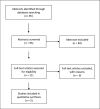Gender Differences in Multiple Endocrine Neoplasia Type 1: Implications for Screening?
- PMID: 32110650
- PMCID: PMC7036590
- DOI: 10.1159/000505498
Gender Differences in Multiple Endocrine Neoplasia Type 1: Implications for Screening?
Abstract
Background: Some gender-related differences have been reported in multiple endocrine neoplasia type 1 (MEN1), although not all reports are conclusive. This systematic review with analysis of the own MEN1 cohort evaluates gender differences and potential consequences for screening.
Methods: A systematic review of the literature between 1990 and 2019 with the search terms "MEN1" or "multiple endocrine neoplasia type 1" and "gender" or "sex" was performed. In addition, the prospectively collected data of a genetically confirmed MEN1 cohort of the Philipps University Marburg were retrospectively analyzed.
Results: Review of the literature identified five retrospective case series with original data of 1,057 MEN1 patients. One series suggested a higher frequency of pancreatic neuroendocrine neoplasms (NEN), especially gastrinomas, in men (61 vs. 54%) and a higher frequency of pituitary tumors in women (47 vs. 30%), but others did not. Only thymic NEN occurred predominantly in men throughout all studies. Women with MEN1 were found to have an increased risk of breast cancer. In the own series consisting of 116 MEN1 patients (male = 58, female = 58), thymic lesions were also more frequently detected in male patients (male = 5, female = 1). No gender difference was found with regard to the other manifestations.
Conclusion: Regarding the typical MEN1 tumor manifestations, gender-adapted diagnostic and therapeutic approaches cannot be recommended. Female MEN1 patients should be encouraged to participate in breast cancer screening programs.
Keywords: Gender; Multiple endocrine neoplasia type 1; Screening.
Copyright © 2020 by S. Karger AG, Basel.
Conflict of interest statement
The authors have nothing to disclose.
Figures
References
-
- Chandrasekharappa SC, Guru SC, Manickam P, Olufemi SE, Collins FS, Emmert-Buck MR, et al. Positional cloning of the gene for multiple endocrine neoplasia-type 1. Science. 1997 Apr;276((5311)):404–7. - PubMed
-
- Manoharan J, Albers MB, Bartsch DK. The future: diagnostic and imaging advances in MEN1 therapeutic approaches and management strategies. Endocr Relat Cancer. 2017 Oct;24((10)):T209–25. - PubMed
-
- Machens A, Schaaf L, Karges W, Frank-Raue K, Bartsch DK, Rothmund M, et al. Age-related penetrance of endocrine tumours in multiple endocrine neoplasia type 1 (MEN1): a multicentre study of 258 gene carriers. Clin Endocrinol (Oxf) 2007 Oct;67((4)):613–22. - PubMed
-
- Thakker RV, Newey PJ, Walls GV, Bilezikian J, Dralle H, Ebeling PR, et al. Endocrine Society Clinical practice guidelines for multiple endocrine neoplasia type 1 (MEN1) J Clin Endocrinol Metab. 2012 Sep;97((9)):2990–3011. - PubMed
Publication types
LinkOut - more resources
Full Text Sources


